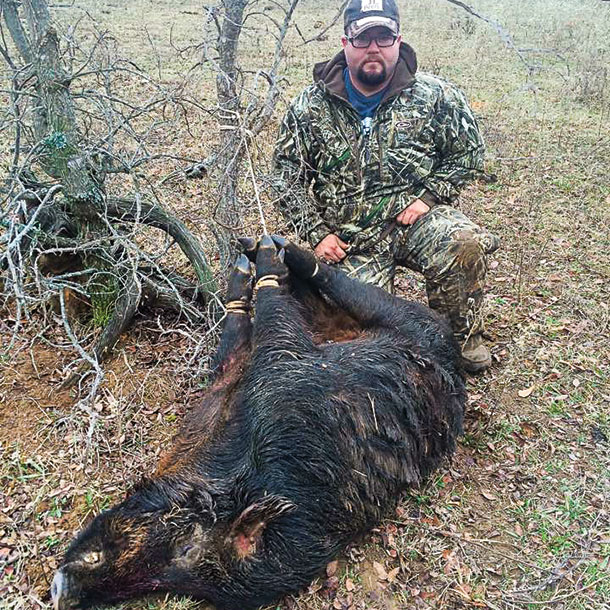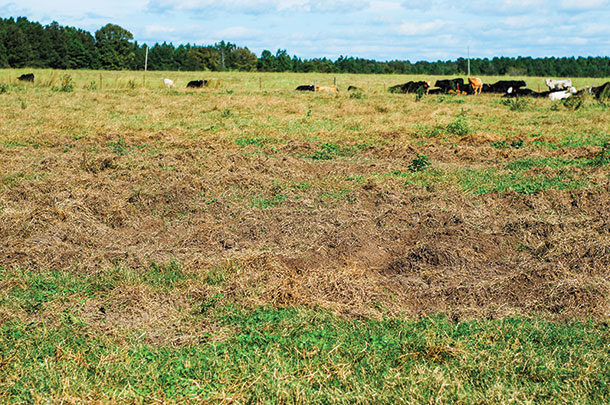Slowly, the realization settles in that you’ve been the victim of a marauding pack of feral hogs.
The term “feral hog” includes Eurasian wild boars, domesticated hogs that became feral and hybrids of the two species. Wild hogs, or feral hogs, are domesticated swine and resulted from free-range livestock management and the frequent escape from enclosures.
Found in 39 states and costing $1.5 billion annually, feral hogs cause extensive damage, primarily to agriculture, rooting crops, damaging forests and timber, destroying pastures and fences, as well as wallowing out and contaminating rivers and streams. Many states have passed legislation to manage the growing feral hog problem.
The damage also impacts homeowners, golf courses, and even historical and archeological sites.
Furthermore, feral hogs pose a disease transmission risk to livestock, pets and people, such as swine brucellosis, leptospirosis, tuberculosis, anthrax and pseudorabies. In 2015, ten southwest Arkansas hunting dogs died after contracting pseudorabies from scavenging a feral hog.
Exacerbating the problem, feral hogs are the most prolific large wild mammal in the U.S. and with adequate nutrition, they have the ability to double their population in four months. Females typically breed between 8 to 10 months of age, but with ideal conditions can breed as young as 6 months.
Sows can produce two litters per year and average between four to eight piglets per litter. Older sows, however, could produce 10 to 13 piglets per litter.
The old saying, “We’ve seen the enemy and it is us” applies to the expanding feral hog problem in the U.S. Feral hogs have been well-established in southern states for years. Rebecca McPeake, professor and wildlife extension specialist with the University of Arkansas Division of Agriculture says, “Feral hog numbers have increased dramatically since the early 1990s, presumably because of hunters releasing hogs for sport.”
Other states, like Kentucky, are newer to the feral hog issue and, according to Matthew Springer, assistant extension professor of wildlife management, Kentucky Department of Forest and Wildlife Resources and USDA are aggressively dealing with the emerging and explosive problem, incorporating traps on private landowners’ property as well as up to three helicopter crews, operated by the USDA, used to shoot sounders.
Springer says, “Feral hog behavior is destructive in all aspects – from destroying wildlife habitat all the way up to killing and consuming wildlife. They are adaptive to different landscapes and have diverse diets and consume a lot of food. They are able to chase off and outcompete native wildlife.”
Julie Leonard of 5000 Ranch in western Arkansas near the Oklahoma border says, “Overnight, they tore up several places covering 15 acres of a bermudagrass field. Then over several nights, they caused the feeder calves to run through multiple fences. They moved across 200 acres in just days, uprooting random locations, but none as extensive as the first night.
“The good news is that it’s winter time and they didn’t destroy actively growing bermudagrass, and we can correct the problem now without loss of production. We will run the disk over the worst places they uprooted to smooth it back down,” Leonard says.
Behavior, habitat and diet
Feral hogs travel in family groups called a sounder, consisting of one or more sows and their offspring and can range in size from as few as two animals to as large as 40 to 50. Adult boars of mating age typically range alone unless they are breeding.
Feral hogs have a range of about 20 square miles depending on availability of food and water; consequently they range larger areas in the fall and winter when food is scarce.
These nocturnal animals rarely move around during the day unless disturbed. Under severe disturbance they will leave an area and light somewhere more safe, up to a few miles away.
Sometimes they return to an area after the disturbance. Hunting or trapping pressure can cause sounders to leave an area for a time, but if there is adequate water, cover and food, they will return.
Feral hogs are attracted to areas with water, such as river bottoms, creeks, lakes, marshes and bayous. They also prefer dense vegetative cover. These two features provide them a mechanism to regulate their body temperatures.
Feral hogs are omnivores with voracious and diverse appetites. They dine on whatever is available and aren’t too picky. They’ll eat wild vegetative material such as tubers, roots, persimmons and acorns, as well as crops such as corn, milo wheat, rice and soybeans. They’ll eat horticultural crops such as pumpkins, watermelon and orchard fruit.
Control methods
McPeake says, “The most successful tactic for controlling feral hogs is corral trapping the sounder. The sounder consists of related sows and their offspring.
Removing a single boar or bachelor group may help alleviate some damage problems in the short term, but a sounder will continue to grow and produce more piglets, which cause more damage. A ‘whole sounder approach’ is the recommended method for controlling feral hog numbers.”
Jennifer Caraway, county extension agent with the University of Arkansas Division of Agriculture says, “The most common methods of control in my county include trapping and hunting with dogs. Most hunters use tracking dogs to bay hogs and catch hogs to contain them.”
Jeremy Jeane, a hog hunter from Miller County Arkansas, says it’s imperative to spend time baiting and conditioning hogs to your trap. “If you don’t catch the whole sounder, you’re wasting your time.” Traps with two openings are 75 percent more likely to be successful. Jeane says the most hogs he has trapped at one time was 17.
Leonard says, “We got the number for the local APHIS (USDA, Animal and Plant Health Inspection Service) guy to help trap and remove the sounder completely. This seems to be the best solution because any other method doesn’t take care of the problem long term.”

Chris Wilson, rancher and hunting guide in Oklahoma says, “We use dogs as one method of control; it’s not really an effective population control method. Hunting with dogs runs the hogs off and will keep them away for a period of time. Out of a good-sized sounder, we might catch three to 10 hogs, and the remaining sounder will leave the area for up to two weeks.”
Many state laws prohibit poisoning, snaring and other methods that may cause harm to off-target species. The Environmental Protection Agency approved a warfarin-based toxicant for hog-targeted poisoning.
In February, Texas Agriculture Commissioner Sid Miller announced a rule change in the Texas Administrative Code that classifies a new warfarin-based pesticide as state-limited use for control of feral hogs.
The pesticide contains warfarin, a toxicant that is effective at low doses in swine with minimum risk in other animals. In addition to a low-dose rate, a specific feeder was developed so that hogs lift a door to reach the poison.
Miller reported to the Texas legislature that this change will save the Texas Department of Agriculture’s budget $900,000 previously earmarked for feral hog control research. Other states, like Louisiana, are considering allowing the use of toxicants.
The feral hog issue is destructive, costly and poses a health risk to domesticated livestock production as well as wildlife. Producers should be vigilant and prepared to use the various proven means to minimize damage to their property. ![]()
PHOTO 1: Feral hogs may severely damage native plants and agricultural crops. If the hogs’ rooting in an area disturbs vegetation, it could cause the type and abundance of plants to shift.
PHOTO 2: Chris Wilson (the author’s brother), a rancher and hunting guide from Oklahoma, is pictured with a feral hog. Photos provided by Melissa Beck.

-
Melissa Beck
- Freelance Writer
- based in Arkansas








